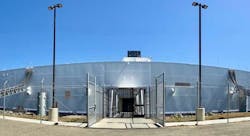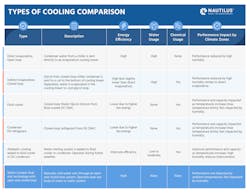Keeping Your Cool While Getting Your Work Done
Of course, there is a key piece of the puzzle that all of these stories tend to ignore: the services that generate this energy consumption are greatly valued by society. This means that new data center construction is more likely to be met with a NIMBY attitude than a claim that “we don’t want the capabilities those super scalers are offering to society.”
Perhaps, that’s because the latter would be a far more difficult argument for the general public to accept, but either way, the arguments against data centers remain consistent. They rely on power usage, noise, the lack of jobs once the facilities are up and running, the long-term value of state subsidies, and the most difficult argument for the industry to refute: the increase in water use.
There are technological solutions to everything
It’s easy to point out the advantages and changes that technology is bringing to the data center. Higher IT workload equipment densities and more powerful computers mean more work is getting done for the amount of power consumed. Advances in battery technologies and more efficient diesel motors have reduced the impact of backup systems on the local environments. Furthermore, communities are getting a better understanding of the advantages that bringing in a data center can offer, and technology solutions seem to be addressing the issues of water utilization.
However, water remains a sticking point. This is despite claims from companies like Amazon that suggest that they will be water-positive in a decade and return more water to the community than they use. At the moment, the fact that data centers can use 3-5 million gallons of water daily significantly impacts the availability of potable water in the areas that surround data centers. As pointed out in Environmental Research letters, one-fifth of data centers' direct water footprint comes from stressed watersheds while as much as 50 percent are powered by plants located in water-stressed regions.
Making use of the advantages of water cooling is the future of the data center
Moving to alternative methods of data center cooling solutions is the best path forward for cooling and conserving resources. The current approach to consuming water must change to a more efficient model. At Nautilus, we believe the most efficient method is when the water is used as a heat-sink to remove heat from the data center. The combination of an open loop to closed-loop cooling systems demonstrates a greatly reduced environmental impact and provides data center operators a new direction to take.
Such systems are designed to never allow water actual contact with IT workload systems and beneficially take the place of current, costly chiller systems.
Closed-loop cooling systems aren’t new. In fact, different versions of this cooling methodology have existed for years, ranging from closed-loop evaporative systems to closed-loop dry cooling systems to liquid-to-liquid cooling systems. But often, these systems couldn’t work with pure water, instead requiring chemical additives to improve the heat transfer. Or potentially, the systems couldn’t guarantee a leak-free operational model, and data center operators rarely want to intentionally increase the risks associated with fluid leaks in a data center.
When compared to other methods, here is how water-cooled, heat sink technology with open and closed loop stacks up:
Redefining the perception of water cooling
Removing environmental, ecological, and sustainability barriers to the deployment of new data centers is a goal all operators should be focused on. Finding ways to achieve these goals that can directly improve the bottom line on these projects is an added bonus. You don’t need to sacrifice power, efficiency, or speed to market to achieve sustainability for your data center operations. You just need to think about data centers in a different light.
Rob Pfleging is the Chief Executive Officer & President of Nautilus Data Technologies. To learn more about the key benefits of water-cooled data centers visit the Nautilus website.




